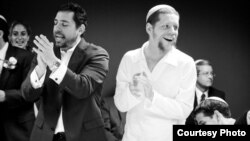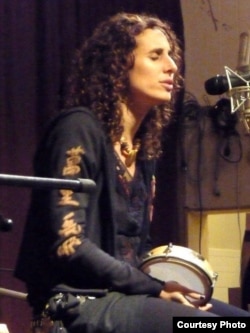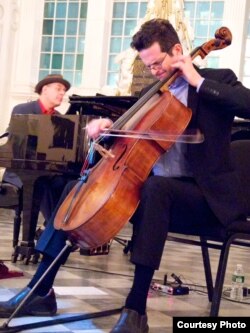NEW YORK —
September 4 through the 14 mark the main Jewish High Holiday season when Jews all over the world undergo 10-days of self-reflection, repentance, music and prayer. The holidays begin on Rosh Hashana, the Jewish New Year, and end with Yom Kippur, the Day of Atonement.
Traditional High Holiday music and liturgy is often hundreds of years old, and older. But some of those traditions are being reshaped by a younger generation of Jews who want to put their own mark on their ancient heritage.
The blast of a “shofar”, the ram’s horn, is the most ancient and traditional of Jewish High Holidays music. For millennia, Jews around the world have sounded it as a wake-up call to repentance. The shofar blast is supposed to mimic soulful sobbing, and to herald the symbolic arrival of God as King on Rosh Hashanah, the Jewish New Year.
Most American Jews with ancestral roots in pre-Holocaust Eastern and Central Europe are also familiar with the chant of the synagogue cantor, or prayer leader.
New traditions
But new traditions are being created by people like Basya Schechter of New York City. Schechter was raised in an Ultra-Orthodox Jewish home that gave women little room for artistry. She left home, travelled the world and returned to her faith deepened by the musical experiences in Africa, South America and the Middle East.
“So I get to connect my old soul, my new complicated self, my travels, my questions my fears, my sadness and it comes out as a song.”
Schechter spends weeks rehearsing for the High Holidays in her other role as cantor and prayer leader at more innovative synagogues. But for her, leading prayer is not a performance, and she does not seek to make the music her own.
“I try to make it something that is ‘our own.’ I want to make it an experience that not only I feel but brings everyone else along in the journey,” she said.
Schechter adds that in many traditional synagogues, the cantor’s prayers are “the wings that everyone else would ride on,” and what the community sang was given less weight.
“And, in our generation, it’s really about the energy and the momentum of the entire community together, creating space for people to have their own experience, whatever that is.”
Communal experience
Schechter continues to find the traditional High Holiday prayers deeply meaningful. She especially loves “"U'Netaneh Tokef Kedushat HaYomam,” a Rosh HaShanah prayer whose Hebrew title translates as “Let Us Tell How Utterly Holy this Day is….”
“And it talks about God being the True Judge. It’s acknowledging his role as the True Judge and giving him the space and the honor and the respect before we pray the other words.”
Composer and cantor Shir Yaakov Feit says he loves the High Holidays music, yet like many of his generation, he finds the constant themes of God’s monarchy and majesty troublesome.
“We don’t find ourselves feeling like the children of royalty, and the models of earthly, powerful leadership are often corrupt and disappointing and sociopathic,” he said.
Feit was raised in a non-traditional Jewish home in an ethnically diverse New York neighborhood, and spent much of his young adulthood exploring the spiritual traditions of other cultures, including meditation and the community chanting of sacred texts. He says that, eventually, he discovered little known strains of those traditions in Judaism.
“There is a text buried somewhere in our tradition that says that ‘the whole Torah is song.’ So for me getting back into my own Judaism and choosing it was through the vehicle of music.”
Shared meditation
For Feit, community chanting of musical prayers during the High Holidays are a form of shared meditation.
“Every note is a breath,” he said, “and there is an incredible sensitivity to each moment that develops the more we sing in community. Which is happening on conscious and completely deep unfathomable levels…And the body is totally alive in the moment of song when singing that way.”
Feit has also composed in the Jewish musical genre called niggunim, wordless repetitive melodies sung by groups that can induce a sense of shared spiritual ecstasy.
“We are now kind of gathering the sparks and rekindling the fire of vibrant, celebratory, complete Jewish spirituality. But it’s with some scar tissue….”
Both the hope and the melancholy of the Jewish People’s journey through history can be heard in “Adapting” composed by the Brooklyn cellist Noah Hoffeld.
It begins with his simple melody for “B’Sefer Chaim,” a High Holidays prayer that expresses the desire for God to be “inscribed in the book of life for happiness and health…. ”
The piece then translates the musical theme from one cultural mode into another – from Spain, North Africa and the Arab countries where millions of Jews once lived, to Central Europe, to America.
“This is very similar to the experience of the Jews over the centuries, traveling, settling in countries, and adapting and absorbing influences,” says Hoffeld, “but at the same time sticking to their own personal identity of Jewishness.”
For Hoffeld re-imagining Jewish music and liturgy for new times and places is itself traditional.
“Except now we do it through the Internet or through just travelling and absorbing influences. You don’t need to settle in a country in order to absorb and incorporate their melodic material, rhythmic material, scales, harmonies, vibes. There’s a loosening of the rulebook. And that’s very exciting.”
Traditional High Holiday music and liturgy is often hundreds of years old, and older. But some of those traditions are being reshaped by a younger generation of Jews who want to put their own mark on their ancient heritage.
The blast of a “shofar”, the ram’s horn, is the most ancient and traditional of Jewish High Holidays music. For millennia, Jews around the world have sounded it as a wake-up call to repentance. The shofar blast is supposed to mimic soulful sobbing, and to herald the symbolic arrival of God as King on Rosh Hashanah, the Jewish New Year.
Most American Jews with ancestral roots in pre-Holocaust Eastern and Central Europe are also familiar with the chant of the synagogue cantor, or prayer leader.
New traditions
But new traditions are being created by people like Basya Schechter of New York City. Schechter was raised in an Ultra-Orthodox Jewish home that gave women little room for artistry. She left home, travelled the world and returned to her faith deepened by the musical experiences in Africa, South America and the Middle East.
“So I get to connect my old soul, my new complicated self, my travels, my questions my fears, my sadness and it comes out as a song.”
Schechter spends weeks rehearsing for the High Holidays in her other role as cantor and prayer leader at more innovative synagogues. But for her, leading prayer is not a performance, and she does not seek to make the music her own.
“I try to make it something that is ‘our own.’ I want to make it an experience that not only I feel but brings everyone else along in the journey,” she said.
Schechter adds that in many traditional synagogues, the cantor’s prayers are “the wings that everyone else would ride on,” and what the community sang was given less weight.
“And, in our generation, it’s really about the energy and the momentum of the entire community together, creating space for people to have their own experience, whatever that is.”
Communal experience
Schechter continues to find the traditional High Holiday prayers deeply meaningful. She especially loves “"U'Netaneh Tokef Kedushat HaYomam,” a Rosh HaShanah prayer whose Hebrew title translates as “Let Us Tell How Utterly Holy this Day is….”
“And it talks about God being the True Judge. It’s acknowledging his role as the True Judge and giving him the space and the honor and the respect before we pray the other words.”
Composer and cantor Shir Yaakov Feit says he loves the High Holidays music, yet like many of his generation, he finds the constant themes of God’s monarchy and majesty troublesome.
“We don’t find ourselves feeling like the children of royalty, and the models of earthly, powerful leadership are often corrupt and disappointing and sociopathic,” he said.
Feit was raised in a non-traditional Jewish home in an ethnically diverse New York neighborhood, and spent much of his young adulthood exploring the spiritual traditions of other cultures, including meditation and the community chanting of sacred texts. He says that, eventually, he discovered little known strains of those traditions in Judaism.
“There is a text buried somewhere in our tradition that says that ‘the whole Torah is song.’ So for me getting back into my own Judaism and choosing it was through the vehicle of music.”
Shared meditation
For Feit, community chanting of musical prayers during the High Holidays are a form of shared meditation.
“Every note is a breath,” he said, “and there is an incredible sensitivity to each moment that develops the more we sing in community. Which is happening on conscious and completely deep unfathomable levels…And the body is totally alive in the moment of song when singing that way.”
Feit has also composed in the Jewish musical genre called niggunim, wordless repetitive melodies sung by groups that can induce a sense of shared spiritual ecstasy.
“We are now kind of gathering the sparks and rekindling the fire of vibrant, celebratory, complete Jewish spirituality. But it’s with some scar tissue….”
Both the hope and the melancholy of the Jewish People’s journey through history can be heard in “Adapting” composed by the Brooklyn cellist Noah Hoffeld.
It begins with his simple melody for “B’Sefer Chaim,” a High Holidays prayer that expresses the desire for God to be “inscribed in the book of life for happiness and health…. ”
The piece then translates the musical theme from one cultural mode into another – from Spain, North Africa and the Arab countries where millions of Jews once lived, to Central Europe, to America.
“This is very similar to the experience of the Jews over the centuries, traveling, settling in countries, and adapting and absorbing influences,” says Hoffeld, “but at the same time sticking to their own personal identity of Jewishness.”
For Hoffeld re-imagining Jewish music and liturgy for new times and places is itself traditional.
“Except now we do it through the Internet or through just travelling and absorbing influences. You don’t need to settle in a country in order to absorb and incorporate their melodic material, rhythmic material, scales, harmonies, vibes. There’s a loosening of the rulebook. And that’s very exciting.”











